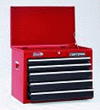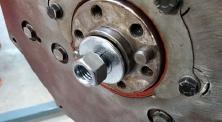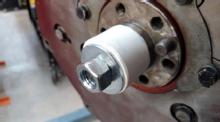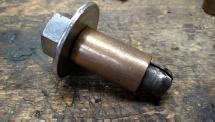

EDITOR NOTE: This is a reprint of a series entitled Just the Tip authored by Thomas Brobst. His ‘make-do-with-what-you-got’ and ingenuity makes for interesting reading and maybe help a poor soul out of a perplexing repair. See if you agree with me this is fun reading.
Just the Tip
Tip #7
 Hello once again faithful Readers! I trust everyone had a wonderful holiday. I hope at least some of you avoided the “bug” that was going around. I didn’t. But, as my dear ol’ dad used to say, “Such are the vicissitudes of life”. I did survive … at least long enough to write this article! So, let’s begin, shall we? Hello once again faithful Readers! I trust everyone had a wonderful holiday. I hope at least some of you avoided the “bug” that was going around. I didn’t. But, as my dear ol’ dad used to say, “Such are the vicissitudes of life”. I did survive … at least long enough to write this article! So, let’s begin, shall we?
 I’m putting my engine back the A. One of the things I wanted to do was replace the squealing pilot bushing in the end of the crankshaft. These little buggers can sometimes be tough to remove. Everyone tells me the easiest way is to fill the bore with grease and then insert a dowel and beat on it with a hammer. The dowel pushes on the grease and the grease presses the bushing out. Well, I tried it and it didn’t work for me. Not to mention you need a dowel that fits the bore reasonably snugly. That’s not always so available. So I have another method that I’ve used for many years. It requires a grinder and a saw, a nut, bolt and washer, a small scrap of sheet metal and a short piece of tubing or pipe. First take a bolt whose shaft is smaller than the bore of the pilot bushing but whose head width is larger that the bushing bore. Oh, and it has to be longer than the bushing by about and inch. The longer the better. Using the saw (hack, jig or band) cut the bolt in half lengthwise. Next, using the grinder, grind the head down, equally on both halves, until it just fits thru the bushing bore when the halves are mated together. Now make a shim by cutting a rectangular strip of sheet metal a little longer than the bolt and as wide as you can make it and still fit it thru the associated nut. The thickness should be the same as the saw blade you used to slit the bolt. You just made a pilot bearing puller! Let’s put it to use. I’m putting my engine back the A. One of the things I wanted to do was replace the squealing pilot bushing in the end of the crankshaft. These little buggers can sometimes be tough to remove. Everyone tells me the easiest way is to fill the bore with grease and then insert a dowel and beat on it with a hammer. The dowel pushes on the grease and the grease presses the bushing out. Well, I tried it and it didn’t work for me. Not to mention you need a dowel that fits the bore reasonably snugly. That’s not always so available. So I have another method that I’ve used for many years. It requires a grinder and a saw, a nut, bolt and washer, a small scrap of sheet metal and a short piece of tubing or pipe. First take a bolt whose shaft is smaller than the bore of the pilot bushing but whose head width is larger that the bushing bore. Oh, and it has to be longer than the bushing by about and inch. The longer the better. Using the saw (hack, jig or band) cut the bolt in half lengthwise. Next, using the grinder, grind the head down, equally on both halves, until it just fits thru the bushing bore when the halves are mated together. Now make a shim by cutting a rectangular strip of sheet metal a little longer than the bolt and as wide as you can make it and still fit it thru the associated nut. The thickness should be the same as the saw blade you used to slit the bolt. You just made a pilot bearing puller! Let’s put it to use.



Put the two bolt halves together, sans shim, and insert it, head first, thru the pilot bushing as far as you can. Now, slide the shim in between the two halves. If you did everything right the head of the bolt will be captured behind the inside end of the bushing.



Next, cut a short piece of tubing to act as a spacer to allow you enough axial movement to actually extract the bushing. I used a piece of PVC pipe I had laying around. Stack the spacer and a washer over the shaft of the split-bolt and then thread the nut onto it. It might take a little practice to get the threads on both halves of the bolt lined up well enough to get the nut started. But once you do you simply turn the nut and the bolt will pull that bushing right out...and Robert is your mother’s uncle! You’ll see from the photos that I had to use two progressive lengths of spacers to get full extraction. That’s because my bolt was too short. If you use a long enough bolt you can do it with one long spacer.


 This technique works well on other blind extraction tasks as well as pilot bushing extraction. I have 3 or 4 sizes of split, ground-head bolts in my bin of “specialty tools” that I’ve had to make over the years. Enjoy. And share your tips too! I’d love to hear them. This technique works well on other blind extraction tasks as well as pilot bushing extraction. I have 3 or 4 sizes of split, ground-head bolts in my bin of “specialty tools” that I’ve had to make over the years. Enjoy. And share your tips too! I’d love to hear them.
~~ Tom Brobst
|